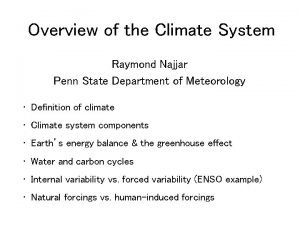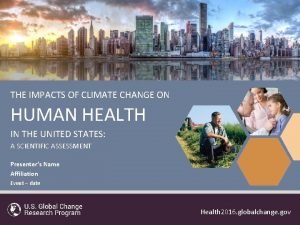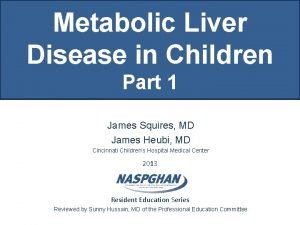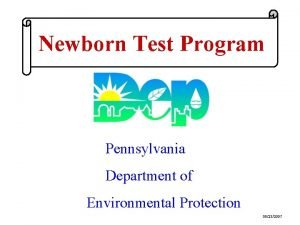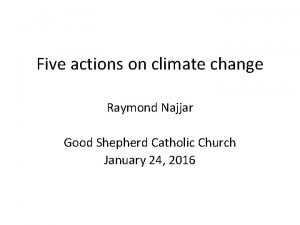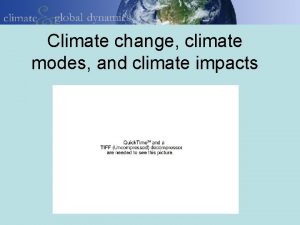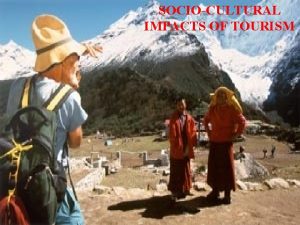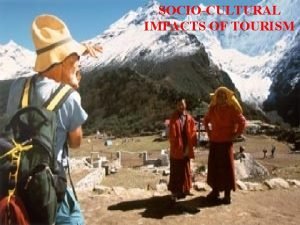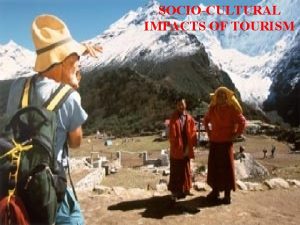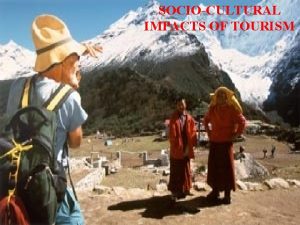Climate impacts on Pennsylvania Raymond Najjar Professor of














- Slides: 14

Climate impacts on Pennsylvania Raymond Najjar Professor of Oceanography Department of Meteorology and Atmospheric Science The Pennsylvania State University Citizens Climate Lobby Mid-Atlantic Conference Philadelphia, PA February 18, 2017

PA Climate Assessments and Updates 2009 Pennsylvania Climate Impact Assessment 2013 Update 2015 advances in modeling techniques: o New greenhouse gas scenarios; o New global climate models o New downscaling techniques 18 -person team led by Jim Shortle Report at psiee. psu. edu/climate-impacts 2015 Update

Pennsylvania is warming by 0. 5 °F per decade (°F/decade) Shortle et al. (2013)

Summers in Pennsylvania will feel like those of the Southeast US by midcentury if heat trapping emissions trends continue http: //psiee. psu. edu/climate-impacts

Expect summers to be drier … … and winters to be wetter 0 8 12 -4 16 Percent precipitation change by 2050 s Kunkel et al. (2013)

Expect heavy downpours to continue to increase Percent change by 2050 s in days > 1” 27 21 15 Kunkel et al. (2013) 21

Sectors v. Energy v. Water quantity & quality v. Agriculture v. Human health v. Forestry v. Tourism & outdoor recreation Image: Penn State Institutes of Energy and the Environment

Energy impacts Increased energy consumption due to more summer cooling (outweighs less winter heating) Reduced availability of cooling water for electric power generation Reduced grid reliability due to stronger storms and floods

Energy How Can Pennsylvania Prepare? Increase the application of energy-efficient technologies Adopt policies to encourage shift of electricity demand to non-peak times Encourage efficient building-integrated sources of backup power Develop smart energy micro-grids to increase resilience of the energy system

Tourism & Outdoor Recreation impacts Longer warm season for outdoor activities but extreme heat periods will increase Some rivers and streams will no longer be suited for cold-water fishing Higher snow-making costs may make ski resorts economically unviable

Tourism and Outdoor Recreation How Can Pennsylvania Prepare? Expect an increased demand for summer outdoor recreation opportunities More educational programs to avoid insect-borne and water-borne diseases People with respiratory diseases and allergies should take extra precaution

Water Quality and Quantity Impacts Peak flows will continue to rise, likely causing higher bank erosion, lower stream health, impaired habitat, and higher sediment outputs Flood risks to infrastructure will increase Ability of wetlands to improve water quality, flood storage, and habitat will be diminished Warming will counteract improvements in dissolved oxygen levels made under the Clean Water Act

Water Quality and Quantity How Can Pennsylvania Prepare? Strengthen flood management infrastructure Improve non-point source pollution control to reduce nutrient and pathogen loading to rivers and streams. Increase programs for monitoring, assessing, and abating water channel degradation. Enhance wetland conservation to maintain/increase the adaptive capacity that these systems provide for stream water quality and quantity.

Factsheets for Public Education http: //psiee. psu. edu/climate-impacts
 Raymond najjar
Raymond najjar Impacts of climate change
Impacts of climate change Professor raymond flood
Professor raymond flood Raymond flood
Raymond flood Königsberg
Königsberg Direct hyperbilirubinemia causes
Direct hyperbilirubinemia causes Kaum anshar adalah
Kaum anshar adalah Samir najjar
Samir najjar Choluric jaundice
Choluric jaundice Crigler najjar
Crigler najjar Prehepatik
Prehepatik Promotion from associate professor to professor
Promotion from associate professor to professor Climate change 2014 mitigation of climate change
Climate change 2014 mitigation of climate change Free radon test kit pennsylvania
Free radon test kit pennsylvania Homestead pennsylvania tourism
Homestead pennsylvania tourism
